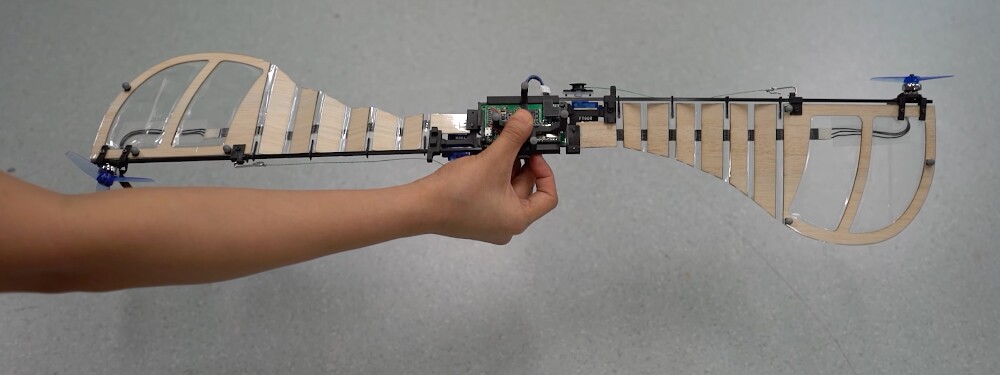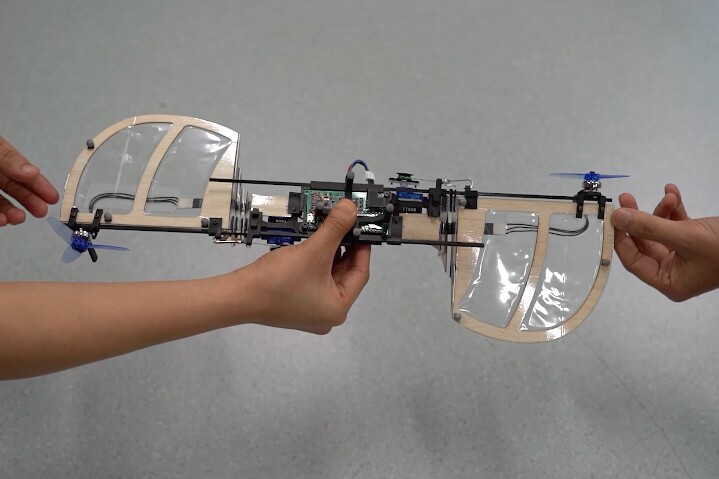Multirotor drones may get all the glory, but fully rotating “monocopters” are actually much more energy-efficient. A new one distinguishes itself even further, as it can squeeze through narrow spaces or drop like a falcon by reducing its wingspan while in flight.
It’s a well-known fact that fixed-wing drones use less battery power than their multirotor counterparts. This is mainly due to the fact that the former’s wings provide a much larger lift surface than the latter’s smaller rotors. Multirotors still have one big advantage, though, in that they can take off and land vertically, and hover on the spot.
Some scientists have set about combining the best features of both designs by creating VTOL (vertical takeoff and landing) drones that fly by horizontally spinning their entire body … and that body takes the form of one big wing.
All of these experimental aircraft were inspired by the one-winged “samara”-type seed of the maple tree, which gracefully spins its way down to the ground when released from the tree.

Depositphotos
That brings us to the FROW (Foldable Rotary Origami Wing) drone, which was created by Hitesh Bhardwaj, Xinyu Cai, Luke Soe Thura Win and Shaohui Foong from the Singapore University of Technology and Design. There are actually two versions of the aircraft, the FROW-A (for Active) and the FROW-P (for Passive).
While the FROW-A does fly by spinning its entire body, it actually has two samara-inspired wings that are joined in the middle by an electronics-equipped hub. Each wing is made up of balsa wood panels encapsulated in a thin polymer membrane, along with a telescoping carbon fiber rod that runs the length of the wing. At the end of each wing is a motor/propeller.

Singapore University of Technology and Design
When in regular flight mode, both wings are left fully extended for maximum lift. If the wingspan needs to be reduced while flying in cramped quarters, two servos located in the hub wind in cables that are attached to each wing’s rod.
This causes each rod to retract inward, taking the rest of the wing with it. The balsa/membrane part of the wing folds up accordion-style as it’s pulled in, ultimately resulting in a 39% reduction in the FROW-A’s total wingspan. When it’s time to re-extend the wings, the servos release the cables, allowing centrifugal force to pull the wings back out.

Singapore University of Technology and Design
Two wings are required because once retracted, a single wing would have to spin so fast that both the propeller motor and the wing-retraction servo would burn out. The FROW-P kind of utilizes this limitation, as it’s designed to rapidly plunge like a falcon when shortened.
Unlike the FROW-A, the P does incorporate just a single wing. And instead of being connected to a servo, its wing-rod cable is connected to an unpowered spring-loaded winding mechanism (located at the non-propeller end of the wing).

Singapore University of Technology and Design
As long as the FROW-P is spinning fast enough to maintain lift, centrifugal force overpowers the spring tension, keeping the wing extended. As soon as the drone’s motor slackens and its spinning speed drops, however, the reduction in centrifugal force allows the spring to reel the wing in, reducing the total wingspan by a whopping 69%.
The aircraft rapidly autorotates downward as a result, but can easily resume lift simply by gunning its motor again. Among other applications, this functionality could allow the FROW-P to bypass hazardous weather conditions when flying at high altitudes, or even evade pursuing aircraft.
A paper on the research was recently published in the journal Bioinspiration & Biomimetics. You can see both versions of the FROW drone in samara-like action, in the video below.
FROW – The first rotary-wing drone that changes its wingspan mid-air
Source: Bioinspiration & Biomimetics
Source of Article


